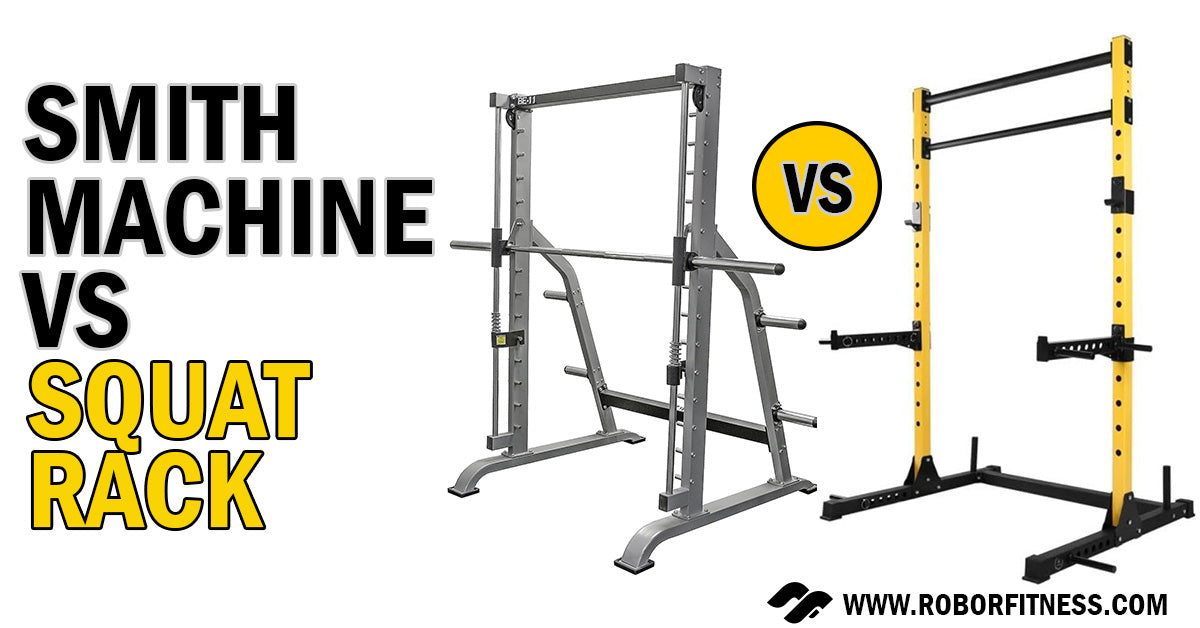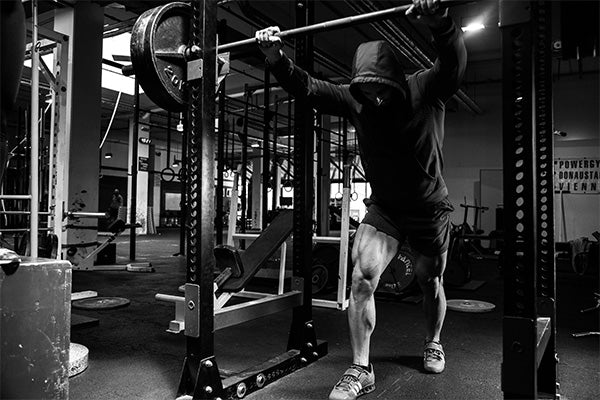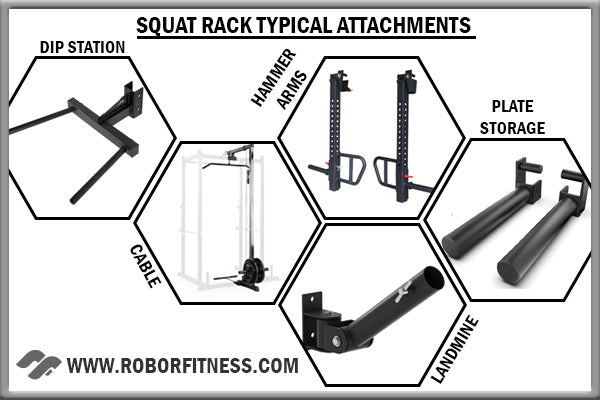Smith Machine Vs Squat Rack: Does One Reign Supreme?
May 23, 2024

When building strength and muscle, the debate between using a Smith Machine vs Squat Rack is as intense as the workouts themselves. Each piece of equipment offers unique benefits, but which one truly reigns supreme?
Whether you're a gym newbie or a seasoned lifter, understanding the differences is critical to maximizing your fitness journey. Today, we'll explore every nook and cranny of these gym staples, helping you make an informed choice for your muscle-building goals. Stay tuned as we break down the pros and cons in a way that's easy to grasp, even for beginners!
What Is a Smith Machine

Before we compare their characteristics side by side, let's quickly recap what each machine is so that we're all on the same page and there's no confusion. First up, the Smith Machine. This gym favorite has a sturdy metal frame with a barbell fixed to vertical track rails. This setup allows the barbell to move in a straight, vertical line, eliminating side-to-side motion.
Now, don't let the naysayers fool you. Despite some unwarranted criticism from self-proclaimed "fitness gurus," the Smith Machine is a fantastic piece of equipment. It's not just a one-trick pony; it has a rightful place in various fitness routines. We'll dive deeper into its benefits later, but for now, know that it's a reliable and versatile tool in your strength training arsenal.
What Is a Squat Rack
Moving on to its counterpart, the Squat Rack, this essential gym piece typically features two vertical uprights connected by a lower cross member.

The primary role of a squat rack is to support a barbell at shoulder height. This setup allows you to easily get underneath the bar, rack it, and perform exercises like squats. But don't be fooled by the name – the squat rack isn't limited to squats. It's incredibly versatile, accommodating a range of exercises such as shoulder presses, lunges, and more.
Adding a bench inside the rack unlocks even more possibilities, including bench presses, seated shoulder presses, and Bulgarian split squats.
Moreover, many squat racks come equipped with a pull-up bar at the top of the uprights. This feature is perfect for strengthening your back and arm with powerful pull-ups and chin-ups.
There are different types of squat racks to consider. The standard version consists of two uprights connected by a single cross member. Then there’s the power rack, an upgraded version of the squat rack. It’s constructed with four uprights and multiple cross members, offering a safer environment for exercises as they’re performed inside the rack.
Lastly, the half rack is a hybrid, combining elements of both the squat and power racks. It has the stability of four uprights like the power rack but is half as deep, requiring exercises to be performed in front of the rack, similar to the standard squat rack.
Smith Machine Vs Squat Rack Side-By-Side
Let's compare the Smith Machine and the Squat Rack side by side to see how they compare in various aspects. While at first glance, they might seem similar, each has unique features and benefits that cater to different needs and preferences in a gym setting.
This comparison will give you a clearer picture of what each rack offers, making your choice between a smith machine and a squat rack well-informed.
Squat Rack Vs. Power Rack – Safety
The Smith Machine takes the crown in the safety department.

As you can see from the picture above, the Smith Machine is equipped with safety catches running the entire length of the machine. This feature is a game-changer for safety. If you're mid-exercise and need to bail on a rep, you can quickly lock the bar onto the nearest latch. This allows you to walk away without risk, making it a superb choice for those who often train alone or push their limits.
In contrast, the squat rack typically includes J-hooks to hold the bar at the starting position and often comes with safety spotter bars. These safety bars are set at the lowest point of your movement, so if you fail a rep, you can let the bar fall onto these arms. However, this system does have its flaws. If you fail a rep at three-quarters of the way up, you'll need to drop to the lowest position for the spotter bars to catch the bar, which can be risky.
Additionally, the spotter bars aren't very deep. If you squat away from the rack, you might miss them entirely on a failed rep. And if you're lifting heavy on a two-upright squat rack, dropping the weight on the spotter bars could potentially cause the rack to topple—a rare but possible scenario.
These risks are virtually non-existent with the Smith Machine, making it a standout choice for safety-conscious lifters.
Smith Machine vs Squat Rack – Experience Level
Your lifting experience plays a crucial role when deciding between the Smith Machine and the Squat Rack. For those new to the gym, diving straight into free weights can be a bit daunting. New lifters often lack the strength in stabilizing muscles necessary to keep the barbell balanced throughout its range of motion. This can lead to an erratic and potentially unsafe bar path.
In such cases, starting with the Smith Machine is a wise choice. It allows you to learn the movement pattern and build a foundational level of strength in a more controlled environment. The Smith Machine guides the bar along a fixed path, reducing the need for stabilizing muscles in the early stages of training. This focused approach helps master the correct form, which is vital for progress and crucial for staying injury-free.
Once you've developed a solid base of strength and proper form on the Smith Machine, transitioning to the Squat Rack becomes a more manageable and safer step. The Squat Rack challenges your stabilizing muscles more, requiring you to control the barbell independently. This progression is essential for advancing in your lifting journey while minimizing the risk of injury.
Smith Machine vs Squat Rack – Muscle Building and Recruitment

The Smith Machine, by its very nature, excels in isolating specific muscle groups, which can be both advantageous and limiting. Consider the squat exercise: performing it on the Smith Machine primarily engages your quadriceps, as the machine's fixed path reduces the need for stabilizing muscles. This focused engagement can significantly stimulate your quads, promoting muscle growth in that area.
Sounds ideal, doesn't it? Well, it's a bit of a double-edged sword. While you can effectively build your quads, the trade-off is the lesser engagement of stabilizing muscles. This aspect is where the Squat Rack has an edge. Using the Squat Rack might not target the quads as intensely as the Smith Machine, but it involves a broader range of muscles.
You end up working not just your quads but also stabilizing muscles like the glutes, spinal erectors, core, and back muscles. This comprehensive muscle engagement is crucial for overall strength and balance.
Ultimately, the choice between the Smith Machine and the Squat Rack boils down to your fitness goals and the composition of your overall workout regime. If your focus is on building specific muscle groups like the quads, the Smith Machine can be a valuable tool. However, if you aim for overall muscle development and strength, incorporating exercises on the Squat Rack to engage stabilizing muscles is essential. Balancing your routine to include both can offer the best of both worlds, depending on your fitness objectives.
Smith Machine vs Squat Rack – Weight Capacity
When it comes to weight capacity, determining whether the Smith Machine or the Squat Rack can handle more weight is a challenge. The answer, frustratingly, is "it depends." It depends on the manufacturer and the materials used to construct the rack.
The critical factor in a rack's weight capacity is the thickness of the steel (measured in gauge) and the size of the tubes used for the frame, which typically range from 2x2 to 3x3 or 2x4 inches. For instance, a rack made with 11-gauge steel (usually the thickest used in racks) and 3x3 tubes will generally support more weight than one constructed with 15-gauge 2x2 steel tubes. Remember, the lower the gauge number, the thicker the steel.
Therefore, it's crucial to check the machine's labeling to ensure it can handle the weight you intend to use. However, it's worth noting that for most gym-goers, both Smith Machines and Squat Racks are designed to handle far more weight than the average person can lift. The concern over weight capacity primarily arises for top-tier powerlifters who are moving exceptionally heavy weights.
Smith Machine vs Squat Rack – Exercise Availability
The squat rack allows you to perform many more exercises you simply can't do on the Smith Machine. For instance, Olympic lifts such as snatches or clean and jerks are practically impossible on the Smith Machine due to its fixed path, but they're entirely feasible with a squat rack. This flexibility makes the squat rack a versatile choice for those who enjoy various exercises.
However, that's not to say the Smith Machine is without its merits. There are numerous effective Smith Machine exercises for specific goals like glute building. These exercises are designed to target the glutes intensively, making the Smith Machine a valuable tool for this particular aspect of strength training.
Personally, the exercises in my program can be performed on either the Smith Machine or squat rack. But if you thrive on variety and like to incorporate a broad spectrum of exercises into your workouts, you might find the Smith Machine a bit limiting. While it's excellent for targeted muscle building, the squat rack's versatility allows for a more diverse exercise repertoire.
Smith Machine vs Squat Rack – Attachments
The squat rack reigns supreme in the realm of attachments. Manufacturers often offer a plethora of attachments, transforming a simple squat rack into a full-blown home gym powerhouse. This adaptability is a significant advantage for those looking to maximize their workout options in a limited space.
Common attachments for squat racks include landmines, cable systems, lat pull-downs, hammer press stations, pull-up bars, weight storage pegs, and dip bars. These additions enhance the variety of exercises you can perform and contribute to a more comprehensive and efficient workout experience.

On the other hand, the Smith Machine falls a bit short in this department. Attachments for Smith Machines are far less common, primarily due to design constraints. The guide rods, essential for the machine's functionality, sit in front of the frame, making it challenging to attach additional equipment directly to the frame.
This limitation means that while the Smith Machine is excellent for specific exercises, its versatility is somewhat limited compared to the squat rack, which can be easily customized with various attachments.
Smith Machine vs Squat Rack – Bar Weight
There's a clear difference between the Smith Machine and the Squat Rack regarding bar weight. With most Olympic bars used in squat racks weighing in at 45 lbs, it's straightforward to calculate your total lift weight. For example, when you add a 45-lb plate on each side, you're lifting a total of 135 lbs—it's that simple.
However, this standardization doesn't apply to Smith Machine bars. The weight of these bars can vary significantly between different machines and brands. I've personally encountered Smith Machines with bars as light as 20 lbs and others as heavy as 50 lbs. This variation was a lesson I learned the hard way.
After switching gyms, I was surprised to find that I couldn't lift the same weight on the new gym's Smith Machine, which had a heavier bar, compared to what I could easily handle at my previous gym. This left me in an embarrassing situation where I had to climb out from underneath the bar with my tail between my legs.
Smith Machine Vs Squat Rack – For Your Home Gym
If you’re weighing up your options for either a Smith Machine or a Squat Rack at home, you will have to consider an extra set of characteristics to help you make an informed choice. When setting up your home gym, space, versatility, and fitness goals are key factors to remember.
While excellent for targeted exercises and safer for beginners, the Smith Machine typically takes up more space due to its fixed structure. It's a great addition to your home gym if you have ample space, are focused on specific muscle group workouts, or need the safety features it offers.
On the other hand, a Squat Rack is generally more compact and versatile. It's ideal for those limited in space but still want various exercise options. With the ability to accommodate various attachments, a squat rack can be a powerhouse for a home gym, allowing for a wide range of exercises from squats to bench presses and pull-ups.
Ultimately, choosing a Smith Machine and a Squat Rack for your home gym depends on your personal fitness goals, available space, and how you plan to diversify your workouts. Both can be valuable home gym essentials, but they cater to different needs and preferences in a home workout environment.
Smith Machine Vs Squat Rack – Cost

When building a home gym, cost often tops the agenda. Investing in gym equipment can be a significant financial commitment, so knowing your budget is crucial before you begin your search.
When comparing costs between a Smith Machine and a Squat Rack, the Smith Machine generally comes out as the more expensive option. This is due to the additional materials and manufacturing complexity involved in its design. On average, a Smith Machine might cost anywhere from 2 to 4 times as much as a Squat Rack.
While this might seem steep, it's important to remember that the Smith Machine is a more sophisticated piece of equipment, offering specific features and safety mechanisms that a squat rack does not.
However, while the squat rack is typically less expensive, it's worth considering the potential additional cost of attachments, which can add versatility but also increase the overall investment.
Ultimately, your choice between a Smith Machine and a Squat Rack should be guided by your budget, fitness goals, and the space you have available. This will ensure that you get the best value for your investment in your home gym.
Smith Machine Vs Squat Rack – Space
When it comes to the space required for gym equipment, a Smith Machine typically demands more room than your standard Squat Rack. Its sophisticated design, with more moving parts, necessitates a larger steel frame for stability. This aspect is crucial to consider when deciding between these two pieces of equipment for your home gym.
Knowing the space you have available can significantly influence your decision. If you're working with limited space, a Squat Rack is likely your best bet. Its more compact design is a significant advantage, and some models even offer the convenience of being packed away when not in use, making it a practical choice for smaller areas.
On the flip side, if you're fortunate enough to have a large space at your disposal, then the size of the Smith Machine won't pose a problem. In this case, space constraints won't be a deciding factor, and you can choose based on other preferences or requirements.
Smith Machine Vs Squat Rack – Moveability
If you value the flexibility to rearrange your gym setup or need to move your equipment after your workouts, a Squat Rack is likely the more suitable choice. Depending on the specific model, many squat racks are designed with enough portability in mind, allowing you to shift them out of the way when they're not in use. This feature is particularly beneficial for those with multipurpose spaces or prefer a change in their workout environment now and then.
In contrast, the Smith Machine is a different story regarding movability. Due to its more complex structure and heavier build, a Smith Machine typically weighs a lot more. Moving it around can be quite a challenge once it's assembled and set up in your space. This lack of portability means that the Smith Machine is better suited for a dedicated spot in your gym where it can remain stationary.
Therefore, when considering the moveability of your gym equipment, the Squat Rack offers more flexibility and ease of rearrangement compared to the Smith Machine, which is more static and better suited for a permanent location.
Our Recommendations
Smith Machine Recommendations
The Valor Fitness Smith Machine BE-11, found on Amazon, is a robust and versatile piece of equipment, ideal for those looking to enhance their home gym. It features a heavy-duty 12-gauge steel frame, ensuring durability and stability during your workouts. The frame is built sturdy, measuring 4x2 inches, contributing to its overall robustness.
One of the critical features of this Smith Machine is its impressive 500-lb weight capacity, which accommodates a wide range of lifting abilities and strengths. This high capacity makes it suitable for beginners and advanced lifters, allowing growth in your strength training journey.
Additionally, the machine includes weight storage pegs, which are convenient for keeping your workout area tidy and help anchor the rack to the floor, adding an extra layer of stability and safety.
The Valor Fitness Smith Machine BE-11 stands out as one of the best Smith machines available. It offers a combination of strength, stability, and convenience for a comprehensive workout experience.
Squat Rack Recommendation
The HulkFit Pro Series Gen 1 Squat Stand Rack, available on Amazon, is a standout choice for those seeking the best squat racks for their fitness needs. This rack is designed to support a substantial weight capacity of up to 800 pounds, making it suitable for various strength levels and lifting styles.
Constructed with durability in mind, the HulkFit Squat Stand is built from heavy-duty materials, ensuring it can withstand the rigors of intense workouts. Its robust design and high weight capacity make it an ideal addition to any home gym, catering to beginners and advanced lifters.
The rack's impressive weight capacity and sturdy construction are complemented by its versatility, allowing for various exercises to be performed. Whether you're focusing on squats, lunges, or other strength training exercises, this squat stand provides the reliability and support needed for effective workouts.
Overall, the HulkFit Pro Series Gen 1 Squat Stand Rack represents a smart investment for those looking to enhance their home gym with one of the best squat racks on the market.
The Final Say
In the showdown between the Smith Machine and the Squat Rack, it's clear that each has its unique strengths and ideal applications. The Smith Machine offers safety and targeted muscle training, perfect for beginners or those focusing on specific muscle groups.
On the other hand, the Squat Rack wins in versatility. It allows for a wider range of exercises and the development of stabilizing muscles, making it a favorite among more experienced lifters.
Your choice ultimately depends on your fitness goals, space, budget, and experience level. Whether you opt for the guided precision of a Smith Machine or the versatile challenge of a Squat Rack, both are valuable tools in your strength training arsenal. Remember, the best equipment is the one that aligns with your fitness journey and helps you safely achieve your goals.






Thomas D
Author
Thomas is a dedicated fitness enthusiast with over 12 years of experience in the gym. As a level 2 qualified gym instructor, he combines his passion for working out and nutrition to help others achieve their fitness goals. Thomas stays up to date with the latest fitness research and follows the work of top experts in the field. With a balance of textbook knowledge and real-life experience, he provides practical guidance to help others reach their full potential.